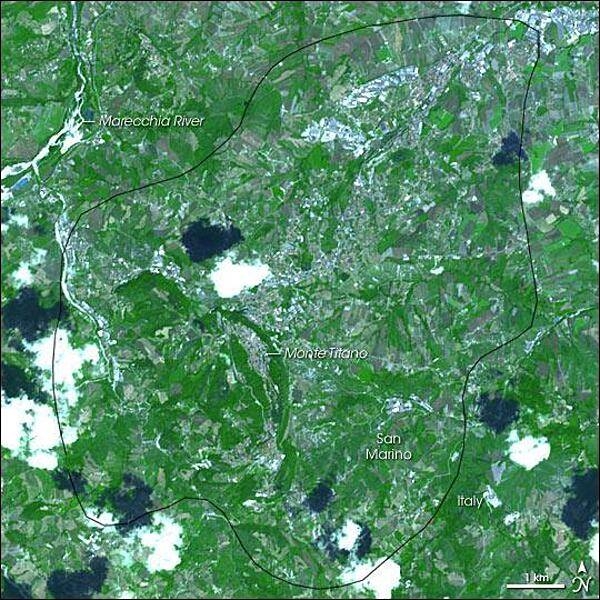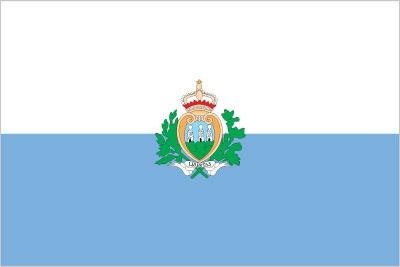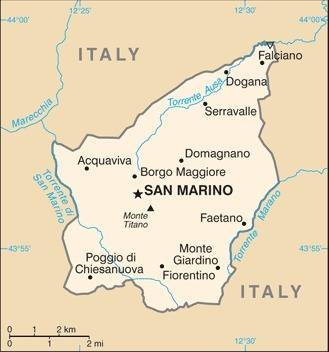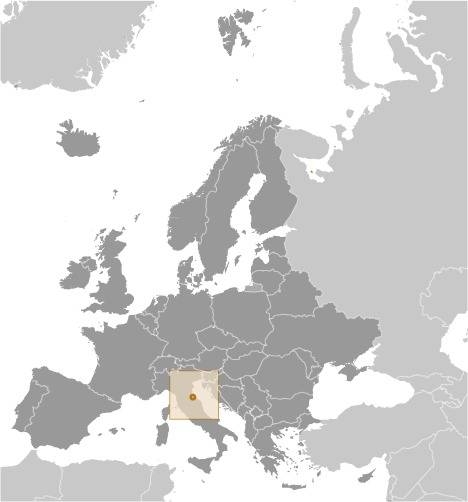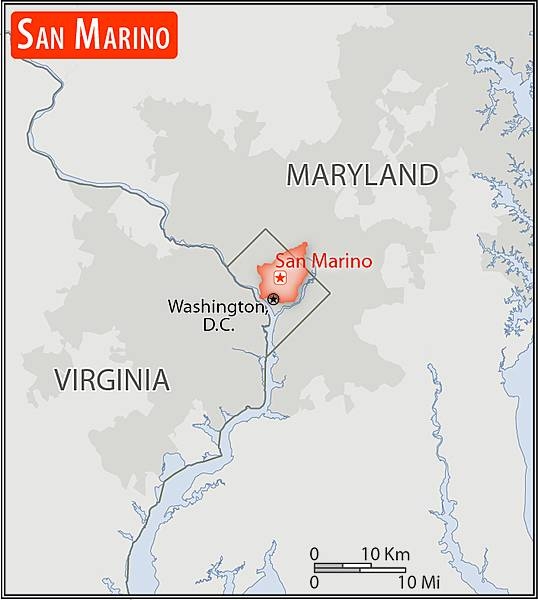San Marino
Introduction
Background
Geographically the third-smallest state in Europe (after the Holy See and Monaco), San Marino also claims to be the world's oldest republic. According to tradition, it was founded by a Christian stonemason named MARINUS in A.D. 301. San Marino's foreign policy is aligned with that of the EU, although it is not a member; social and political trends in the republic track closely with those of its larger neighbor, Italy.
Visit the Definitions and Notes page to view a description of each topic.
Geography
Location
Southern Europe, an enclave in central Italy
Geographic coordinates
43 46 N, 12 25 E
Map references
Europe
Land boundaries
total: 37 km
border countries (1): Italy 37 km
Coastline
0 km (landlocked)
Maritime claims
none (landlocked)
Climate
Mediterranean; mild to cool winters; warm, sunny summers
Terrain
rugged mountains
Elevation
highest point: Monte Titano 739 m
lowest point: Torrente Ausa 55 m
Natural resources
building stone
Land use
agricultural land: 16.7% (2018 est.)
arable land: 16.7% (2018 est.)
permanent crops: 0% (2018 est.)
permanent pasture: 0% (2018 est.)
forest: 0% (2018 est.)
other: 83.3% (2018 est.)
Irrigated land
0 sq km (2022)
Natural hazards
occasional earthquakes
Geography - note
landlocked; an enclave of (completely surrounded by) Italy; smallest independent state in Europe after the Holy See and Monaco; dominated by the Apennine Mountains
People and Society
Nationality
noun: Sammarinese (singular and plural)
adjective: Sammarinese
Ethnic groups
Sammarinese, Italian
Languages
Italian
major-language sample(s):
L'Almanacco dei fatti del mondo, l'indispensabile fonte per le informazioni di base. (Italian)
The World Factbook, the indispensable source for basic information.
Religions
Roman Catholic
Age structure
0-14 years: 14.73% (male 2,662/female 2,379)
15-24 years: 11.64% (male 2,091/female 1,894)
25-54 years: 39.12% (male 6,310/female 7,081)
55-64 years: 14.28% (male 2,367/female 2,520)
65 years and over: 20.24% (male 3,123/female 3,805) (2020 est.)
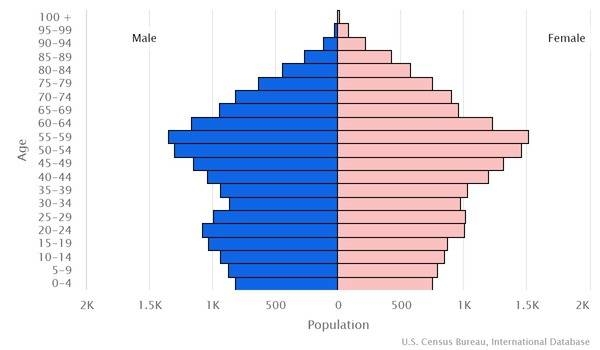
Dependency ratios
total dependency ratio: 49.6
youth dependency ratio: 19.6
elderly dependency ratio: 30
potential support ratio: 3.3 (2021)
Median age
total: 45.2 years
male: 43.9 years
female: 46.3 years (2020 est.)
Urbanization
urban population: 97.8% of total population (2023)
rate of urbanization: 0.41% annual rate of change (2020-25 est.)
Major urban areas - population
4,000 SAN MARINO (2018)
Sex ratio
at birth: 1.09 male(s)/female
0-14 years: 1.1 male(s)/female
15-24 years: 1.13 male(s)/female
25-54 years: 0.9 male(s)/female
55-64 years: 0.92 male(s)/female
65 years and over: 0.7 male(s)/female
total population: 0.93 male(s)/female (2022 est.)
Mother's mean age at first birth
31.9 years (2019)
Infant mortality rate
total: 6.51 deaths/1,000 live births
male: 7.72 deaths/1,000 live births
female: 5.19 deaths/1,000 live births (2022 est.)
Life expectancy at birth
total population: 83.86 years
male: 81.3 years
female: 86.65 years (2022 est.)
Drinking water source
improved: urban: NA
rural: NA
total: 100% of population
unimproved: urban: NA
rural: NA
total: 0% of population (2020)
Current health expenditure
6.4% of GDP (2019)
Physicians density
6.11 physicians/1,000 population (2014)
Hospital bed density
3.8 beds/1,000 population (2012)
Sanitation facility access
improved: urban: NA
rural: NA
total: 100% of population
unimproved: urban: NA
rural: NA
total: 0% of population (2020)
Literacy
total population: 99.9%
male: 99.9%
female: 99.9% (2018)
School life expectancy (primary to tertiary education)
total: 12 years
male: 13 years
female: 12 years (2021)
Youth unemployment rate (ages 15-24)
total: 27.4%
male: 21.4%
female: 36% (2016 est.)
Environment
Environment - current issues
air pollution; urbanization decreasing rural farmlands; water shortage
Environment - international agreements
party to: Biodiversity, Climate Change, Climate Change-Kyoto Protocol, Climate Change-Paris Agreement, Comprehensive Nuclear Test Ban, Desertification, Endangered Species, Nuclear Test Ban, Ozone Layer Protection, Whaling
signed, but not ratified: Air Pollution
Air pollutants
particulate matter emissions: 13.45 micrograms per cubic meter (2016 est.)
methane emissions: 0.02 megatons (2020 est.)
Climate
Mediterranean; mild to cool winters; warm, sunny summers
Land use
agricultural land: 16.7% (2018 est.)
arable land: 16.7% (2018 est.)
permanent crops: 0% (2018 est.)
permanent pasture: 0% (2018 est.)
forest: 0% (2018 est.)
other: 83.3% (2018 est.)
Urbanization
urban population: 97.8% of total population (2023)
rate of urbanization: 0.41% annual rate of change (2020-25 est.)
Revenue from forest resources
forest revenues: 0% of GDP (2018 est.)
country comparison to the world: 195Waste and recycling
municipal solid waste generated annually: 17,175 tons (2016 est.)
municipal solid waste recycled annually: 7,737 tons (2016 est.)
percent of municipal solid waste recycled: 45.1% (2016 est.)
Government
Country name
conventional long form: Republic of San Marino
conventional short form: San Marino
local long form: Repubblica di San Marino
local short form: San Marino
etymology: named after Saint MARINUS, who in A.D. 301 founded the monastic settlement around which the city and later the state of San Marino coalesced
Government type
parliamentary republic
Capital
name: San Marino (city)
geographic coordinates: 43 56 N, 12 25 E
time difference: UTC+1 (6 hours ahead of Washington, DC, during Standard Time)
daylight saving time: +1hr, begins last Sunday in March; ends last Sunday in October
etymology: named after Saint MARINUS, who in A.D. 301 founded a monastic settlement around which the city and later the state of San Marino coalesced
Administrative divisions
9 municipalities (castelli, singular - castello); Acquaviva, Borgo Maggiore, Chiesanuova, Domagnano, Faetano, Fiorentino, Montegiardino, San Marino Citta, Serravalle
Independence
3 September 301 (traditional founding date)
National holiday
Founding of the Republic (or Feast of Saint Marinus), 3 September (A.D. 301)
Constitution
history: San Marino’s principal legislative instruments consist of old customs (antiche consuetudini), the Statutory Laws of San Marino (Leges Statutae Sancti Marini), old statutes (antichi statute) from the1600s, Brief Notes on the Constitutional Order and Institutional Organs of the Republic of San Marino (Brevi Cenni sull’Ordinamento Costituzionale e gli Organi Istituzionali della Repubblica di San Marino) and successive legislation, chief among them is the Declaration of the Rights of Citizens and Fundamental Principles of the San Marino Legal Order (Dichiarazione dei Diritti dei Cittadini e dei Principi Fondamentali dell’Ordinamento Sammarinese), approved 8 July 1974
amendments: proposed by the Great and General Council; passage requires two-thirds majority Council vote; Council passage by absolute majority vote also requires passage in a referendum; Declaration of Civil Rights amended several times, last in 2019
Legal system
civil law system with Italian civil law influences
International law organization participation
has not submitted an ICJ jurisdiction declaration; accepts ICCt jurisdiction
Citizenship
citizenship by birth: no
citizenship by descent only: at least one parent must be a citizen of San Marino
dual citizenship recognized: no
residency requirement for naturalization: 30 years
Suffrage
18 years of age; universal
Executive branch
chief of state: co-chiefs of state Captain Regent Maria Luisa BERTI and Captain Manuel CIAVATTA (for the period 1 October 2022 - 1 April 2023)
head of government: Secretary of State for Foreign and Political Affairs Luca BECCARI (since 8 January 2020)
cabinet: Congress of State elected by the Grand and General Council
elections/appointments: co-chiefs of state (captains regent) indirectly elected by the Grand and General Council for a single 6-month term; election last held in September 2022 (next to be held in March 2023); secretary of state for foreign and political affairs indirectly elected by the Grand and General Council for a single 5-year term; election last held on 28 December 2019 (next to be held by November 2024)
election results: Maria Luisa BERTI and Manuel CIAVATTA elected captains regent; percent of Grand and General Council vote - NA; Luca BECCARI (PDCS) elected secretary of state for foreign and political affairs; percent of Grand and General Council vote - NA
note: the captains regent preside over meetings of the Grand and General Council and its cabinet (Congress of State), which has 7 other members who are selected by the Grand and General Council; assisting the captains regent are 7 secretaries of state; the secretary of state for Foreign Affairs has some prime ministerial roles
Legislative branch
description: unicameral Grand and General Council or Consiglio Grande e Generale (60 seats; members directly elected in single- and multi-seat constituencies by list proportional representation vote in 2 rounds if needed; members serve 5-year terms)
elections: last held on 8 December 2019 (next to be held by 31 December 2024)
election results: percent of vote by coalition/party - PDCS 35%, Tomorrow in Movement coalition 25% (RETE Movement 18.3%, DML 6.7%), Liberia 16.7%, We for the Republic 13.3%, RF 10%; seats by coalition/party - PDCS 21, Tomorrow in Movement coalition 15 (RETE Movement 11, DML 4), Liberia 10, We for the Republic 8, RF 6; composition (as of September 2022) - men 40, women 20, percent of women 33.3%
Judicial branch
highest court(s): Council of Twelve or Consiglio dei XII (consists of 12 members); note - the College of Guarantors for the Constitutionality and General Norms functions as San Marino's constitutional court
judge selection and term of office: judges elected by the Grand and General Council from among its own to serve 5-year terms
subordinate courts: first instance and first appeal criminal, administrative, and civil courts; Court for the Trust and Trustee Relations; justices of the peace or conciliatory judges
Political parties and leaders
Domani - Modus Liberi or DML [Lorenzo Forcellini REFFI]
Free San Marino (Libera San Marino) or Libera [Luca BOSCHI]
Future Republic or RF [Mario VENTURINI]
I Elect for a New Republic
Party of Socialists and Democrats or PSD [Paride ANDREOLI]
RETE Movement [Gloria ARCANGELONI]
Sammarinese Christian Democratic Party or PDCS [Marco GATTI]
Socialist Party or PS [Alessandro BEVITORI]
Tomorrow in Movement coalition (includes RETE Movement, DML)
We for the Republic [Denise BRONZETTI]
International organization participation
CE, FAO, IAEA, IBRD, ICAO, ICC (NGOs), ICCt, ICRM, IDA, IFRCS, ILO, IMF, IMO, Interpol, IOC, IOM (observer), IPU, ITU, ITUC (NGOs), LAIA (observer), OPCW, OSCE, Schengen Convention (de facto member), UN, UNCTAD, UNESCO, Union Latina, UNWTO, UPU, WHO, WIPO
Diplomatic representation in the US
chief of mission: Ambassador Damiano BELEFFI (since 21 July 2017)
chancery: 327 E 50th Street, New York, NY 10022; Embassy address: 1711 North Street NW (2nd Floor), Washington, DC 22036
telephone: [1] (212) 751-1234
[1] (202) 223-24l8
[1] (202) 751-1436
FAX: [1] (212) 751-1436
email address and website:
sanmarinoun@gmail.com
Diplomatic representation from the US
embassy: the United States does not have an Embassy in San Marino; the US Ambassador to Italy is accredited to San Marino, and the US Consulate General in Florence maintains day-to-day ties
Flag description
two equal horizontal bands of white (top) and light blue with the national coat of arms superimposed in the center; the main colors derive from the shield of the coat of arms, which features three white towers on three peaks on a blue field; the towers represent three castles built on San Marino's highest feature, Mount Titano: Guaita, Cesta, and Montale; the coat of arms is flanked by a wreath, below a crown and above a scroll bearing the word LIBERTAS (Liberty); the white and blue colors are also said to stand for peace and liberty respectively
National symbol(s)
three peaks each displaying a tower; national colors: white, blue
National anthem
name: "Inno Nazionale della Repubblica" (National Anthem of the Republic)
lyrics/music: no lyrics/Federico CONSOLO
note: adopted 1894; the music for the lyric-less anthem is based on a 10th century chorale piece
National heritage
total World Heritage Sites: 1 (cultural)
selected World Heritage Site locales: San Marino Historic Center and Mount Titano
Economy
Economic overview
San Marino's economy relies heavily on tourism, banking, and the manufacture and export of ceramics, clothing, fabrics, furniture, paints, spirits, tiles, and wine. The manufacturing and financial sectors account for more than half of San Marino's GDP. The per capita level of output and standard of living are comparable to those of the most prosperous regions of Italy.
San Marino's economy contracted considerably in the years since 2008, largely due to weakened demand from Italy - which accounts for nearly 90% of its export market - and financial sector consolidation. Difficulties in the banking sector, the global economic downturn, and the sizable decline in tax revenues all contributed to negative real GDP growth. The government adopted measures to counter the downturn, including subsidized credit to businesses and is seeking to shift its growth model away from a reliance on bank and tax secrecy. San Marino does not issue public debt securities; when necessary, it finances deficits by drawing down central bank deposits.
The economy benefits from foreign investment due to its relatively low corporate taxes and low taxes on interest earnings. The income tax rate is also very low, about one-third the average EU level. San Marino continues to work towards harmonizing its fiscal laws with EU and international standards. In September 2009, the OECD removed San Marino from its list of tax havens that have yet to fully adopt global tax standards, and in 2010 San Marino signed Tax Information Exchange Agreements with most major countries. In 2013, the San Marino Government signed a Double Taxation Agreement with Italy, but a referendum on EU membership failed to reach the quorum needed to bring it to a vote.
Real GDP (purchasing power parity)
$2.06 billion (2019 est.)
$2.01 billion (2018 est.)
$1.982 billion (2017 est.)
note: data are in 2017 dollars
Real GDP growth rate
1.9% (2017 est.)
2.2% (2016 est.)
0.6% (2015 est.)
Real GDP per capita
$60,800 (2019 est.) note: data are in 2017 dollars
$59,600 (2018 est.) note: data are in 2017 dollars
$58,867 (2017 est.)
GDP (official exchange rate)
$1.643 billion (2017 est.)
Credit ratings
Fitch rating: BB+ (2020)
note: The year refers to the year in which the current credit rating was first obtained.
GDP - composition, by sector of origin
agriculture: 0.1% (2009)
industry: 39.2% (2009)
services: 60.7% (2009)
GDP - composition, by end use
household consumption: (2011 est.) NA
government consumption: (2011 est.) NA
investment in fixed capital: (2011 est.) NA
investment in inventories: (2011 est.) NA
exports of goods and services: 176.6% (2011)
imports of goods and services: -153.3% (2011)
Agricultural products
wheat, grapes, corn, olives; cattle, pigs, horses, beef, cheese, hides
Industries
tourism, banking, textiles, electronics, ceramics, cement, wine
Labor force - by occupation
agriculture: 0.2%
industry: 33.5%
services: 66.3% (September 2013 est.)
Youth unemployment rate (ages 15-24)
total: 27.4%
male: 21.4%
female: 36% (2016 est.)
Household income or consumption by percentage share
lowest 10%: NA
highest 10%: NA
Budget
revenues: 667.7 million (2011 est.)
expenditures: 715.3 million (2011 est.)
Fiscal year
calendar year
Exports - partners
Romania 10%, France 9%, Germany 8%, United States 8%, Austria 6%, Brazil 6%, Poland 6%, Russia 6%, (2019)
Exports - commodities
industrial washing/bottling machinery, packaged medicines, woodworking machinery, foodstuffs, aircraft (2019)
Imports - partners
Germany 21%, Italy 13%, Poland 10%, France 7%, Spain 7%, Belgium 6%, Romania 6% (2019)
Imports - commodities
electricity, cars, aluminum, footwear, natural gas, iron piping (2019)
Reserves of foreign exchange and gold
$392 million (2014 est.)
$539.3 million (2013 est.)
Exchange rates
euros (EUR) per US dollar -
0.885 (2017 est.)
0.903 (2016 est.)
0.9214 (2015 est.)
0.885 (2014 est.)
0.7634 (2013 est.)
Energy
Electricity access
electrification - total population: 100% (2020)
Communications
Telephones - fixed lines
total subscriptions: 16,000 (2020 est.)
subscriptions per 100 inhabitants: 47 (2020 est.)
Telephones - mobile cellular
total subscriptions: 39,000 (2020 est.)
subscriptions per 100 inhabitants: 115 (2020 est.)
Telecommunication systems
general assessment: automatic telephone system completely integrated into Italian system (2018)
domestic: fixed-line a little over 47 per 100 and mobile-cellular teledensity roughly 115 telephones per 100 persons (2020)
international: country code - 378; connected to Italian international network
note: the COVID-19 pandemic continues to have a significant impact on production and supply chains globally; since 2020, some aspects of the telecom sector have experienced a downturn, particularly in mobile device production; progress toward 5G implementation has resumed, as well as upgrades to infrastructure; consumer spending on telecom services has increased due to the surge in demand for capacity and bandwidth; the crucial nature of telecom services as a tool for work and school from home is still evident, and the spike in this area has seen growth opportunities for development of new tools and increased services
Broadcast media
state-owned public broadcaster operates 1 TV station and 3 radio stations; receives radio and TV broadcasts from Italy (2019)
Internet users
total: 20,318 (2019 est.)
percent of population: 60% (2019 est.)
Broadband - fixed subscriptions
total: 11,000 (2020 est.)
subscriptions per 100 inhabitants: 32 (2020 est.)
Transportation
Military and Security
Military and security forces
Military Corps (National Guard): Guard of the Rock (or Fortress Guard), Uniformed Militia, Guard of the Great and General Council, Corps of the Gendarmerie; Ministry of Internal Affairs: Civil Police Corps (2022)
note: the captains regent oversee the Gendarmerie and National Guard when they are performing duties related to public order and security; the Ministry of Foreign Affairs exercises control over such administrative functions as personnel and equipment, and the courts exercise control over the Gendarmerie when it acts as judicial police
Military service age and obligation
18 is the legal minimum age for voluntary military service; no conscription; government has the authority to call up all San Marino citizens from 16-60 years of age to serve in the military (2022)
Military - note
defense is the responsibility of Italy
Transnational Issues
Disputes - international
none identified
